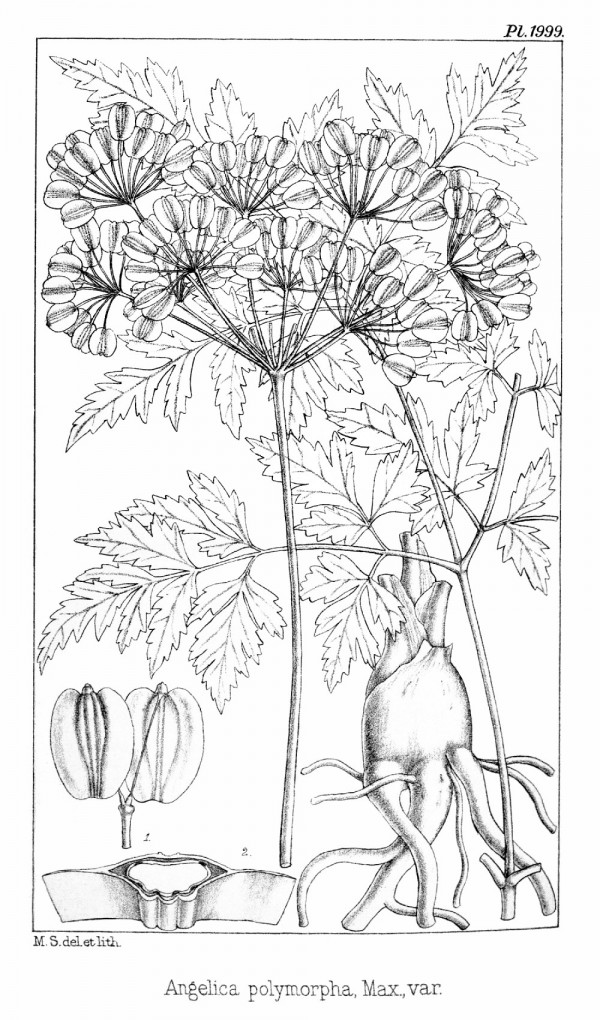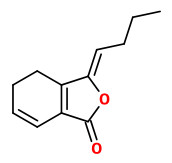Angelica sinensis (Oliver) Diels - syn. Angelica polymorpha Maxim. var. sinensis Oliv. - Apiaceae
当归 dang gui (chin.), dong quai, Chinesische Engelwurz
Perennial, 0.4-1m tall, native to China; root cylindric, branched, rootlets many, succulent, strongly aromatic; stem purplish green, ribbed, branched above; inferior leaves tripinnate, superior leaves often simply pinnate; leaflets ovate or ovate-lanceolate, margin irregularly coarse-cuspidate-serrate; inflorescence an multiforous umbel with irregular rays; petals white, rarely purplish red.
The roots are frequently used in the important traditional Chinese medicine dang gui.
var. sinensis (fruit ellipsoid or ovate, vittae 1-2 on commissure)
var. wilsonii (fruit obovoid or suborbicular, vittae absent on commissure)
http://www.efloras.org/florataxon.aspx?flora_id=2&taxon_id=200015389
„Dong quai is used for menstrual cramps, premenstrual syndrome (PMS), and menopausal symptoms. It is also used orally as a ”blood purifier”; to manage hypertension, infertility, joint pain, ulcers, “tired blood” (anemia), and constipation; and in the prevention and treatment of allergic attacks. Dong quai is also used orally for the treatment of loss of skin color (depigmentation) and psoriasis. Some men apply dong quai to the skin of the penis as part of a multi-ingredient preparation for treating premature ejaculation… The effectiveness ratings for DONG QUAI are as follows:
Possibly effective for… Premature ejaculation, when applied directly to the skin of the penis in combination with other herbs. The other herbs are Panax ginseng root, Cistanches deserticola, Zanthoxyl species, Torlidis seed, clove flower, Asiasari root, cinnamon bark, and toad venom (SS Cream).
Possibly ineffective for… Menopausal symptoms.
Dong quai might slow blood clotting. Taking dong quai along with medications that also slow clotting might increase the chances of bruising and bleeding.“
http://www.nlm.nih.gov/medlineplus/druginfo/natural/936.html
„The roots of Angelica sinensis (Danggui), a traditional Chinese medicine, have been used for invigorating blood circulation for over 2000 years in China. Three common species of Angelica roots are found in Asia: A. sinensis from China, A. acutiloba from Japan, and A. gigas from Korea. By using a molecular genetic approach, the 5S-rRNA spacer domains of the three species of Angelica were amplified, and their nucleotide sequences were determined. Diversity in DNA sequences among various species was found in their 5S-rRNA spacer domains, which could serve as markers for authentic identification of Angelica roots. In chemical analyses, the main constituents of Angelica roots including ferulic acid and Z-ligustilide were determined by HPLC; roots of A. sinensis were clearly distinct in that they contained ∼10-fold higher levels of ferulic acid and Z-ligustilide as compared to roots of A. acutiloba and A. gigas. In addition, the amounts of main constituents in roots of A. sinensis varied according to different regions of cultivation and different methods of preservation. The chemical profile determined by HPLC therefore could serve as a fingerprint for quality control of Angelica roots.“
[Molecular genetic and chemical assessment of radix Angelica (Danggui) in China. Zhao, K. J., Dong, T. T., Tu, P. F., Song, Z. H., Lo, C. K., Tsim, K. W., Journal of Agricultural and Food Chemistry, 51(9), 2003, 2576-2583]
„Bioassay-guided fractionation of the chloroform extract from the roots of Angelica sinensis led to isolation and characterization of (Z)-ligustilide using direct-bioautography with Colletotrichum species. The structure of (Z)-ligustilide was confirmed by 1H and 13C NMR spectroscopy and GC/MS. (Z)-Ligustilide deterred the biting of two mosquito species more effectively than DEET. Three different A. sinensis accessions and one Angelica archangelica root oil were evauated by GC and GC/MS, and the dominant component in A. sinensis was 61-69% (Z)-ligustilide. Two other prominent compounds in A. sinensis oils were 5.7-9.8% (E)-3-butylidene phthalide and 1.5-2.3% (Z)-3-butylidene phthalide…
(Z)-Ligustilide is unstable in air and requires refrigeration and is best stored under nitrogen at 4°C in an amber vial.“
[Bioactivity-guided fractionation and GC/MS fingerprinting of Angelica sinensis and Angelica archangelica root components for antifungal and mosquito deterrent activity. Wedge, D. E., Klun, J. A., Tabanca, N., Demirci, B., Ozek, T., Baser, K. H. C., Zhang, J. (2008)., Journal of agricultural and food chemistry, 57(2), 2009, 464-470] http://www.afpmb.org/sites/default/files/pubs/dwfp/publications/FY09/Wedge/Wedge2009.pdf

Angelica polymorpha var. sinensis
Hooker, W.J., Hooker, J.D., Icones Plantarum [Hooker’s] Icones plantarum], vol.20 t.1999 (1891) [M.Smith]
http://plantgenera.org/species.php?id_species=63675
